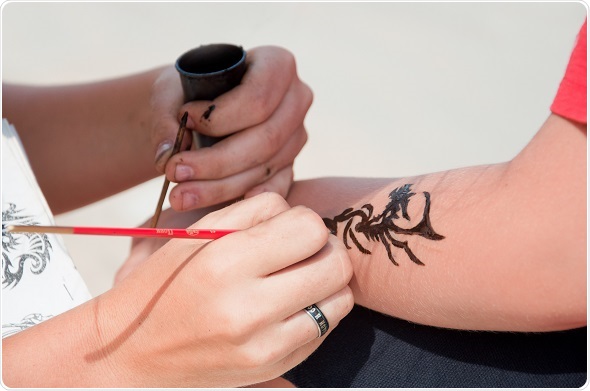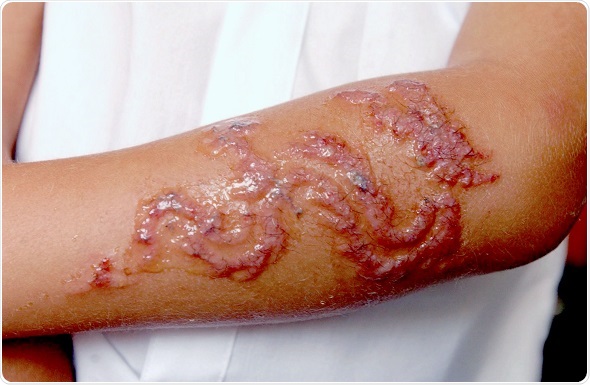By Dr Chris Flower, Director-General of CTPA and a Chartered Biologist & Toxicologist
What are ‘black henna’ temporary tattoos?
While on holiday, many people opt to have a ‘fun’ temporary henna tattoo applied when they’re on the beach, by the pool or when at a festival. These are often advertised as ‘black henna’ temporary tattoos (BHTT), but there is no such thing as ‘black henna’: true henna extract is orange-red in colour.

So-called BHTTs are not henna at all, but are usually mixed with a substance called PPD (paraphenylenediamine or p-phenylenediamine). This use of PPD is illegal in the EU and PPD can be very harmful if applied direct to the skin in the high concentrations often used in these types of temporary tattoos.
BHTTs can cause painful short and long term damage to skin and potentially lifelong allergy to PPD.
What is the concern?
The concern is that many people are unaware of the risks they run when having a BHTT. The British Skin Foundation (BSF) recently conducted a survey1 of dermatologists at the 2015 British Association of Dermatologists’ Annual Meeting, to ascertain if they are seeing an increase in reactions at their clinics to BHTTs.
Why to avoid black henna temporary tattoos
The results were interesting and worrying, and led to the BSF issuing a Press Release in August warning the public of the dangers of BHTTs.
In particular parents hoping to treat their children to a temporary tattoo on holiday or at the funfair, along with party-goers at festivals, may not realise the problems that BHTTs can cause.
The warnings were backed by the CTPA (the Cosmetic, Toiletry and Perfumery Association) which is the UK trade body representing the cosmetics industry.
The BSF questionnaire highlighted:
- 4 out of 10 dermatologists asked had seen patients with skin reactions to BHTTs.
- 1 in 20 dermatologists approached said that over 80% of the BHTT reactions they had seen were in children aged under 16.
- The dermatologists asked confirmed that around half of the patients got a BHTT outside of the EU, where the legal status of PPD is not always clear; however the other half got a BHTT within the EU, with 27% of these in the UK.
- About two-thirds of dermatologists approached have seen an increase in patients with reactions to hair dyes, many of whom have previously had a BHTT.
Previous research conducted by YouGov for the CTPA in 2012 had revealed one in ten British people have had a potentially dangerous BHTT.2
- Almost half of these had the BHTT done on holiday.
- 18-24 year olds were the most likely age group to have had a BHTT.
What are the risks from BHTTs?
PPD is used safely and legally as a hair dye and is regulated at European level by the Cosmetic Products Regulation (EC) No 1223/2009. Under these laws, PPD may only be used in hair colorants up to a maximum concentration of 2%, as applied to the hair, and products have to carry specific labelling instructions and warnings. However, PPD is not allowed for any other use in cosmetics.
Temporary tattoos which paint colour onto the skin are classed as cosmetic products in Europe and use of PPD in this sort of product is illegal in the EU. Other areas in the world have their own legal requirements and the laws for such temporary tattoos may be different, although some countries’ authorities have issued warnings on the dangers of BHTTs.
What is the risk from PPD?
When applied to the skin in the form of a BHTT, often at high concentrations, PPD can cause redness, swelling, blistering and even chemical burns. Some reactions can take many months to heal and can leave the person with a scar in the shape of the tattoo that might never completely fade.

As well as the immediate harmful effects and the risk of scarring, BHTTs can also cause sensitisation to PPD. Although we cannot predict who might become sensitised, those who do may develop painful allergic contact dermatitis if they are exposed to PPD in the future.
What is the link to hair dyes?
Since PPD is used in many hair dyes, there is a risk that people who have been sensitised to PPD from a BHTT could react badly to a hair dye without knowing they may have a problem. Also, as allergies can build up over time, repeated exposure to PPD even in hair dyes can, in some people, lead to them being sensitised. This is why hair dye manufacturers advise that an allergy alert test is always performed 48 hours before the hair is to be coloured to identify people who might be sensitised to PPD before risking a bad reaction to a hair dye.
If PPD is identified as the cause, it is important to avoid all future contact with it. The European Cosmetic Products Regulation requires all cosmetics to declare all of the ingredients on the label so people can identify which hair dyes they should avoid.
Dr Anjali Mahto,Consultant Dermatologist & British Skin Foundation Spokesperson, offers the following advice to her colleagues:
Black henna is well known to cause skin reactions and should be treated with caution, particularly in children. Individuals presenting to dermatology outpatients with a history suggestive of contact allergy to hair dye should also be questioned closely regarding previous reactions to black henna. In most cases, patients with a reaction to PPD who present to outpatients are usually rash free and the reaction has occurred at some point in the past. In these cases, patient photographs can be extremely helpful. When patients acutely present, usually as an emergency appointment, a range of skin changes can be visible. These include redness, itching, blistering, and swelling. Long-term, there may be residual pigmentation changes in the skin at the site of PPD application.”
References
1 The British Skin Foundation survey was undertaken at the British Association of Dermatologists’ Annual Meeting between the 6-9 July 2015 in Manchester. Only dermatologists were invited to take part and were identified by their delegate badge. 244 completed the survey of which 56 were male and 188 were female. The survey included questions from the British Skin Foundation, other companies, as well as the CTPA. It was blind, unbranded (due to it being run on the British Skin Foundation stand) and respondents received no financial reward.
2 Polling conducted by YouGov Plc. Total sample size was 2053 adults, fieldwork undertaken online between 12-15 October 2012. The figures have been weighted and are representative of all UK adults (aged 18+).
Further Reading
Disclaimer: This article has not been subjected to peer review and is presented as the personal views of a qualified expert in the subject in accordance with the general terms and condition of use of the News-Medical.Net website.